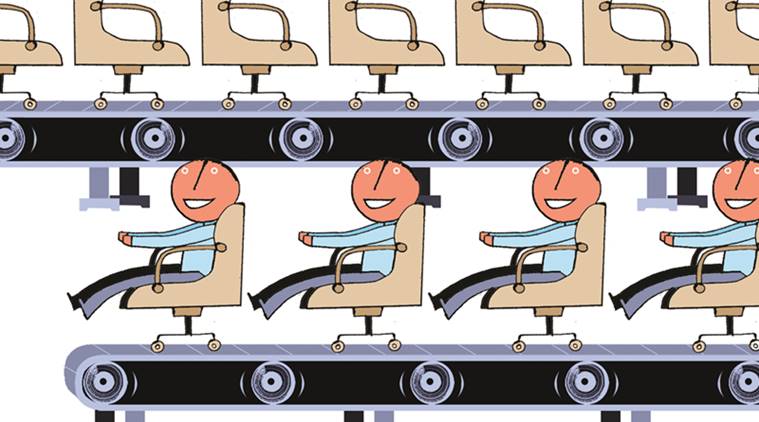Jobs and votes
The maximum number of claims of jobless growth have been made in 2018. But it may well be the year of maximum employment gains in the last 15 years.

In the two labour bureau surveys conducted in 2014 and 2015, the job gain was 0.3 million. (C R Sasikumar)
I have long believed, and with some conviction based on reality, that Indian voters, like their counterparts in other democracies, vote with their feet. The origin of the phrase, “voting with your feet”, is with Charles Tiebout, a US economist who died at the age of 43, but not before seminally advancing the concept that people vote with their feet, that is, they migrate to jurisdictions where spending is closer to their preferences. For example, middle-class parents will move to jurisdictions with good public schools, and don’t mind paying higher property taxes to meet their “ideological” objectives.
After Tiebout came Bill Clinton with his political theory of voting — it is the economy, stupid. There have been several tests of this thesis, worldwide, and something I will explore in some detail in a forthcoming book on voting behaviour in India.
If it is feet and voting, can the issue of jobs be far behind? For some time now, the buzz has been that Prime Minister Narendra Modi and the BJP are in trouble for the simple reason that the economy has not been doing well, and certainly not close to the promise of “acche din”. It is shouted from the rooftops that there are no jobs, and as proof, the CMIE-BSE survey results are offered — employment in January-April 2017 was 405 million — a year later, for January-April 2018, employment had declined by 3.3 million to 401.7 million. This is the largest one-year job loss in the CMIE survey since its inception in January 2016.
In the two labour bureau surveys conducted in 2014 and 2015, the job gain was 0.3 million. (See joint paper with Tirtha Das, ‘All you wanted to know about jobs in India — but were afraid to ask’ at http://goo.gl/Y5CLtF and ssbhalla.org). And remember that the 2014 survey was before Modi became PM, and the 2015 survey was in the midst of the second successive drought.
If this evidence was not enough, there is the constant observation that if X number of jobs are offered in the public sector (state governments or public sector units — the central government is not hiring) there will be a 1,000X applicants. Even the prestigious Financial Times had a story on this in September 2015 — for 368 peon jobs in UP government, there were 2.32 million applications. More recently, Business Today (March 30) reported that there is the story of 25 million applicants for 90,000 jobs in the Railways. Those who think or believe that the job situation is bad in 2018, consider the following — in 2015, there were 630 applicants for a state-sector job; in 2018 there are “only” 278 applicants!
But does this mean that the people looking for a government job are jobless, or that they are smart and want a job, perks and all (little work and even less accountability!)? During my recent trip to Karnataka, just before the state election, I met a young fisherman with a motorbike. He did not consider being a fisherman a job — he considered himself jobless. Maybe he is one of the 25 million.
Employment is a serious issue. Job creation in fiscal 2017/18 is a weighty economic and political question. If job-creation is close to zero (or even negative as claimed by CMIE), then Mahagathbandhan or not, the BJP will find it difficult to repeat its stellar 2014 performance. On the other hand, if the economy is good, and jobs are being created, then the voter will vote with her feet and likely reward the BJP, all other things being equal. This is not to suggest that caste, religion or opposition unity do not matter in elections. Of course they do. The limited point being made is that the state of the economy, and provision of jobs, are important necessary elements for election victories; and that jobs, and the economy, are more than first among equals.
In our report, Das and I go in some detail on the nature of the labour market in India. All things considered, we find that 12.8 million jobs were created in India in 2017/18. The reader can go through the paper for details. Some of the findings are:
It is popularly believed that PM Modi had promised the generation of 10 million jobs a year. We find no record of any such statement. In the 2014 election manifesto of the BJP, there is the following statement: “The country has been dragged through 10 years of jobless growth by the Congress-led UPA Government”. At a campaign rally in Agra in August 2013, candidate Modi did talk about the lack of job generation in the UPA years. In the speech, Modi promised that if the BJP/NDA was elected to office, it would create 10 million jobs for the youth of the country. This is the only reference to job creation.
The Modi government has undertaken some reforms specifically geared towards employment. For example, the emphasis on road construction (a labour-intensive activity), the MUDRA initiative (provision of loans to small entrepreneurs), and wage subsidies to employers hiring new workers (the government pays for the employee contribution to provident fund).
Quarterly employment surveys (QES), conducted for only labour-intensive industries, and covering less than 5 per cent of the total workforce in the economy (establishments with more than 10 workers) are available. The last such survey was for October 2017 and it revealed that employment increased by a cumulative 0.507 million. On a base of 20 million (underlying worker population of QES), this represents a 2.53 per cent rate of increase — extrapolated to the entire non-farm workforce of 350 million, this represents a 9-million job gain.
GDP growth of 5.8 per cent in construction in FY18 was the largest in the last six years. The acceleration in construction GDP in FY18 was the highest in the last 20 years. This construction activity is estimated to have added between 1.7 and 3 million jobs in FY18.
Pulak Ghosh, professor at IIM Bangalore, and Soumya Ghosh, group chief economic adviser of the SBI, present the first ever payroll-based estimate of employment change in India. Establishment payrolls contain employee contributions to provident fund or social security payments (EPFO). The latest Ghosh and Ghosh (G&G) update (July 17) is that a minimum of 10 million jobs were created in FY18 — this is after G&G take elaborate measures to correct the data for double-counting (that is counting as new jobs as those who have newly joined the EPFO system).
Our study into the past (and partial present) has led us to re-examine some of the prevailing conclusions about the job market in India. The first “finding” is that it is incorrect to conclude, based on historical labour force participation trends, that India needs 12 million (range often mentioned is 10-14 million jobs) jobs a year. The reality is closer to 7-8 million jobs and the highest needed, over the last 20 years, was the 10 million estimate for 2004/5.
Related to this result is the finding that the size of the 15-24 age group is expected to increase by only 2.5 million over the next five years (from 236.2 million in 2017 to 238.7 million in 2022). Both the demographic dividend and high population growth are now part of history. The national fertility rate is now at replacement levels (2.1 children per woman) and the population growth rate has declined to just 1.1 per cent a year, from the 1.8 per cent level of two decades earlier.
Summarising (the reader is invited to study, and critique our paper), it does appear likely that FY18 was a bumper year for employment — close to a 13-million job gain. However, some of this (seemingly) outsized employment gain in FY18 might be payback for two successive droughts, and major economic reforms (demonetisation and GST). What is ironic is that the year for which there has been the maximum number of claims of jobless growth may turn out to be the year of maximum job gains in the last 15 years.
The writer is a senior India analyst at Observatory Group, a New York-based macro policy advisory group, and part-time member of the Prime Minister’s Economic Advisory Council. Views are personal
For all the latest Opinion News, download Indian Express App
More From Surjit S Bhalla
- Job gains versus fake analysisLet us debate facts or close approximations. Let discussions on government’s economic performance rise above the unintelligent discourse that passes for analysis..
- India is middle income now: Raise the poverty lineRegardless of the poverty line used, it appears that India is on track for the fastest pace of poverty reduction in the period between 2011/12…
- Let the elite payTo reform education system, provide a level playing field, regardless of caste, sex, or income. Stop subsidising higher education for the rich. ..







































No hay comentarios:
Publicar un comentario